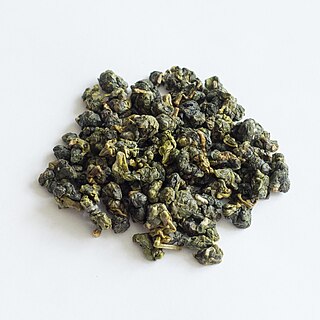
Tea is an aromatic beverage prepared by pouring hot or boiling water over cured or fresh leaves of Camellia sinensis, an evergreen shrub native to East Asia which probably originated in the borderlands of southwestern China and northern Myanmar. Tea is also made, but rarely, from the leaves of Camellia taliensis. After plain water, tea is the most widely consumed drink in the world. There are many different types of tea; some have a cooling, slightly bitter, and astringent flavour, while others have profiles that include sweet, nutty, floral, or grassy notes. Tea has a stimulating effect in humans, primarily due to its caffeine content.

Genmaicha is a Japanese brown rice green tea consisting of green tea mixed with roasted popped brown rice. It is sometimes referred to colloquially as "popcorn tea" because a few grains of the rice pop during the roasting process and resemble popcorn, or as "people's tea", as the rice served as a filler and reduced the price of the tea, making it historically more available for poorer Japanese. Today all segments of society drink genmaicha. It was also used by people fasting for religious purposes or who found themselves to be between meals for long periods of time.

Teh talua or teh telur is a tea beverage from West Sumatra, Indonesia. The tea is unique due to its use of egg yolk in its preparation. Chicken or duck egg can be used to prepare the tea. Other ingredients, in addition to tea and egg yolk, include sugar and calamondin.

Rougui tea is a variety of the tea plant, commonly grown in the Wuyi Mountains and processed into oolong tea. The name literally means "cassia". The tea can be difficult to prepare, but its distinctive sweet aroma can be brought out up to 7 steepings. It was first developed during the Qing dynasty.

Shui Jin Gui is a Wuyi oolong tea from Mount Wuyi, Fujian, China. Its name literally means 'golden water turtle'. The tea produces a bright green color when steeped and is much greener than most other Wuyi oolong teas. It is one of the Si Da Ming Cong, the four famous teas of Wuyi.

Tieluohan or Tie Luo Han is one of the Four Great Oolongs and a light Wuyi tea. Tieluohan is the cultivar responsible for one of the four best known Yán chá, "rock teas" grown on cliffs in the Wuyi Mountains in northern Fujian Province, China. Legend tells that this tea was created by a powerful warrior monk with golden-bronze skin, hence the name Tieluohan, which means "Iron Arhat" or "Iron Warrior Monk".

Bai Ji Guan or Bai Jiguan is a very light Si Da Ming Cong tea, a well-known oolong tea of Wuyi, in Fujian, China.

Kukicha (茎茶), or twig tea, also known as bōcha (棒茶), is a Japanese blend made of stems, stalks, and twigs. It is available as a green tea or in more oxidised processing. Kukicha has a unique flavour and aroma among teas, due to its being composed of parts of the tea plant that are excluded from most other teas.

Teh Botol is an Indonesian jasmine tea drink produced by the company Sosro and sold worldwide. It is sweetened and usually served cold. In addition, Sosro also sells the tea in signature glass bottles as well as Tetra Pak and plastic bottle packaging.

High-mountain tea or gaoshan tea refers to several varieties of Oolong tea grown in the mountains of central Taiwan. It is grown at altitudes higher than 1,000 metres (3,300 ft) above sea level, and includes varieties such as Alishan, Dayuling, Yu Shan, Wushe, and Lishan. The high humidity and natural precipitation in the high mountain ranges of Nantou and Chiayi Counties make the region a suitable environment for growing tea plants. High Mountain Oolong is a tea that holds all of its original nutrients that are within the unfermented green tea. It does not hold the usual grass-like taste, hints of chestnut flavor paired with nutty aromas are often described. The fermentation process that removes the harsh ingredients allows the tea to taste flavorful.

Epicatechin gallate (ECG) is a flavan-3-ol, a type of flavonoid, present in green tea. It is also reported in buckwheat and in grape.

Gold Peak Tea is a brand of ready-to-drink iced tea manufactured by The Coca-Cola Company. It was first introduced in 2006 while a chilled version was launched in 2009. Past formulations of the product had won the ChefsBest award for best taste when it was made with tea leaves from the Kenyan Rift Valley. As of 2019, Gold Peak tea is no longer made from concentrate and is now brewed and bottled in their juice plants.

Ruan zhi or ruanzhi is a cultivar of the tea plant that is usually processed into oolong. The tea is also known as qingxin or #17. It originates from Anxi County in Fujian province, in the People's Republic of China. The taste is light and the aroma is often compared to orchids. This tea variety is used to produce famous highland oolong teas such as tung-tin, Oriental beauty, and baozhong.

Jin Xuan is a variety of oolong tea developed in 1980. The tea is also known as #12 or as "Milk Oolong". It originates from Taiwan. The taste is light, creamy, and flowery and sometimes compared to milk. This tea variety can be grown at higher altitudes, and the yield is about 20% higher compared to traditional tea varieties. These circumstances made it one of the most popular varieties among tea farmers in Taiwan and Thailand. While genuine Jin Xuan naturally tastes milky, some producers produce artificial Jin Xuan through additives.
The London Tea Auction was a candle auction of tea, that ran regularly for over 300 years from 1679 until its closure on 29 June 1998. The auction made London the centre for tea's international trade. The East India Company held the first auction in Leadenhall Street and then in 1834 - after the East India Company ceased to be a commercial enterprise - the auction was held on Mincing Lane.
To the uninitiated a Tea sale appears to be a mere arena in which the comparative strength of the lungs of a portion of his Majesty´s subjects are to be tried. No one could for an instant suspect the real nature of the business for which the assemblage was congregated...

The Tea Party Community was a social networking and political networking website intended as an alternative to Facebook for use by American conservatives, founded by Ken Crow, Tim Selaty, Sr. and Tim Selaty, Jr. in November 2012 and launching on February 2, 2013.

Jinjunmei (金駿眉) is a celebrated black tea from the Wuyi Mountains in Fujian Province, China. It is made exclusively from the buds plucked in early spring from the tea plant. The buds are subsequently fully oxidized and then roasted to yield a tea that has a sweet, fruity and flowery flavour with a long-lasting sweet after-taste. The brew is bright reddish in colour. It is a representative of high-end black tea in Fujian and has now become one of the most expensive varieties of black tea in China.

Dong Ding, also spelled Tung-ting, is an oolong tea from Taiwan. A translation of Dong Ding is "Frozen Summit" or "Icy Peak", and is the name of the mountain in Taiwan where the tea is cultivated. Those plants were brought to Taiwan from the Wuyi Mountains in China's Fujian Province about 150 years ago.

The KDHP Tea Museum is an industry and history museum situated in Munnar, a town in the Idukki district of Kerala in South India. Tata Tea Museum is its official name, but it's also known as Nullathanni Estate where it is located, or Kannan Devan Hills Plantation (KDHP) Tea Museum.

Dried lime tea, also known as chai noomi basra, noomi basra tea or loomi tea, is a type of herbal tea made from dried limes that is traditional to the Arabian Peninsula.

















